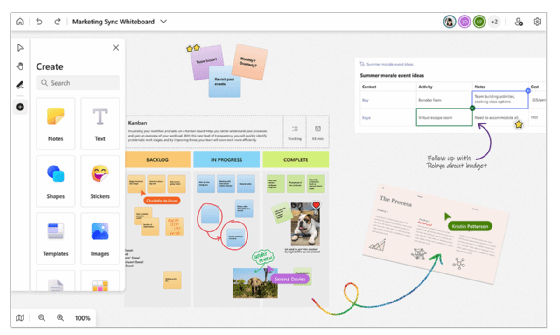
Rymden - stock.adobe.com
Hybrid meetings, virtual whiteboards clash with outdated rooms
As companies look to integrate virtual whiteboard software into their conference rooms for hybrid meetings, they should start investing in meeting room hardware.
Years ago, before the COVID-19 pandemic, conference rooms were key collaboration areas. Employees would meet in person to brainstorm ideas and jot down notes on dry-erase whiteboards. Remote attendees, however, were deprived of the collaboration buzz, couldn't always see the whiteboard and were often relegated to audio-only communications through speakerphones.
Now, it seems the conference room tables have turned, so to speak. Remote work drives collaboration camaraderie, while many conference rooms remain empty. Remote work also boosted the adoption of virtual whiteboard applications as distributed teams sought ways to collaborate visually, annotate ideas and sketch out concepts.
In the future, the reality could lie somewhere in the middle in the form of hybrid meetings as some meeting attendees are remote and some are in the office. The idea of meshing hybrid meetings and virtual whiteboarding highlights a stark reality: Many meeting rooms are not equipped to support workers' newfound expectations for video conferencing and visual collaboration.
"In the short term, the rooms are definitely not ready," said Irwin Lazar, president and principal analyst at Metrigy.
Virtual whiteboard and hybrid meeting challenges
Despite the surging popularity of virtual whiteboard software among remote workers, these applications were not designed for a group of people sitting around a meeting room, Lazar said. Fully remote teams with, say, six people in six different locations might have an easier time whiteboarding on a video call than three people remote and three people in a meeting room. If everyone is remote, at least they have their own workstations.
Many virtual whiteboard apps were largely designed for desktop environments, Lazar said. As businesses consider reopening offices and conference rooms, they'll need to strategize how best to access and use virtual whiteboard software in meeting spaces.
If or when companies head back to the office, they'll need to figure out how to construct their meeting rooms, said David Maldow, founder and CEO of Let's Do Video. Companies will need to build meeting rooms with the understanding that half the people in the meeting won't be in the room. Although the room may still have an actual whiteboard on the wall, the real whiteboard experience might be software-based and embedded in video calls.
"Now, the room has to be a hybrid room," Maldow said. "It has to be a hybrid experience. It's not a room meeting; it's a Zoom meeting because half your team is not there."
Overcome challenges by investing in hardware
If not equipped correctly for hybrid meetings, conference rooms could become the second-class citizens that remote attendees were before the pandemic. One clear way to overcome this obstacle is to invest in meeting room hardware, Lazar and Maldow said.
Ideally, to support hybrid meetings and virtual whiteboard collaboration, companies would invest in and outfit their meeting rooms with large touchscreen monitors. These hardware devices, also known as digital whiteboards, would enable in-office meeting attendees to annotate the virtual whiteboard space and be on equal footing with remote attendees.
Before and during the pandemic, digital whiteboards did not see significant adoption, according to Metrigy research. Now, Lazar said he expects to see more demand for meeting room hardware as companies look to upgrade their collaboration spaces. The hiccup with hardware, however, is companies struggle to glean ROI, Lazar said. In that case, companies could find value in touchscreens that support both whiteboarding and video conferencing.
Examples of digital whiteboard hardware include Cisco Webex Board, Google's Jamboard and Microsoft's Surface Hub 2S. Examples of virtual whiteboard software include Lucidspark, Miro and Mural. The hardware devices have native whiteboarding, and the software applications can integrate with other systems as well.
In addition to touchscreens, companies may want to deploy multiple cameras in their conference rooms. Multiple cameras can capture the faces of people in the room and display them in individual boxes on the video conference screen. In this setup, in-office and remote attendees would appear in the familiar video grid layout. This may require in-room people to remain stationary, however, which is not ideal.

Huddle rooms become hybrid rooms
Remember huddle rooms? They were a hot topic before the pandemic. These small meeting spaces were ideal for three to six people and equipped with conferencing technologies. Nowadays, with an infectious virus lingering in the air, no one wants to huddle in a tight space with co-workers.
But, back in the heyday of huddle rooms, several vendors were rolling out huddle room kits, which included cameras, speakerphones and video conferencing capabilities. Huddle room systems could now make a comeback as hybrid room systems, Maldow said.
Never missing a sales opportunity, several unified communications vendors have seized on the hybrid movement and positioned their products around room-based systems, hybrid setups and virtual whiteboarding.
Zoom Rooms, for example, runs a different kind of software than the desktop version. The room-based software is designed specifically for meetings rooms and for in-room attendees to access and control the software, which includes virtual whiteboarding. The software also integrates with touchscreen hardware boards. Microsoft, too, announced updates to its Microsoft Whiteboard, touting the tool as a visual collaboration workspace designed for hybrid work.
Going forward, Lazar said, before companies even plan an office redesign and possibly revamp collaboration spaces, they'll have to define the overall purpose of the office.







